The ghost pepper is one of the most notoriously spicy peppers on the planet. It is a result of ancient plant breeding, and is a cross between the species Capsicum chinense and Capsicum fructescens.
In the late 2000s, ghost peppers became famous as the hottest peppers in the world. The name was perfect for such a super-spicy pepper, and gardeners began growing them all around the globe.

| Name | Ghost pepper, bhut jolokia |
| Type | Heirloom |
| Species | Capsicum chinense x C. frutescens |
| Heat Level (Scoville) | 1,000,000 SHUs |
| Flavor | Floral, smoky, pungent |
| Color | Green to red |
| Uses | Hot sauces, chili powder |
| Light | Full sun or afternoon shade |
| Watering | Evenly moist, good drainage |
| Seeds | Botanical Interests or Rare Seeds |
| Buy Fresh | Here |
In This Article:
- What is a ghost pepper
- Ghost pepper plants
- Ghost pepper scoville scale
- Ghost pepper varieties
- Growing ghost peppers
- When to pick ghost peppers
- Where to buy fresh ghost peppers
- Ghost pepper uses
- Ghost pepper burn cure
What Is A Ghost Pepper
The ghost pepper, or bhut jolokia, is a pepper variety originally discovered in India. It is thought to be a Capsicum chinense variety that was at some point likely crossed with a Capsicum frutescens variety. It is now well-known for its intense heat and unique, wrinkly shape.
Where Is The Ghost Pepper From?
All Capsicum chinense varieties likely originated in South America and across the West Indies. One of the oldest peppers was found over 6,000 years ago, fully preserved in a cave in Peru.
The ghost pepper is thought to have origins in Trinidad where many of the world’s hottest peppers are found. Eventually, it made its way to Assam and Nagaland, India by way of human trade.
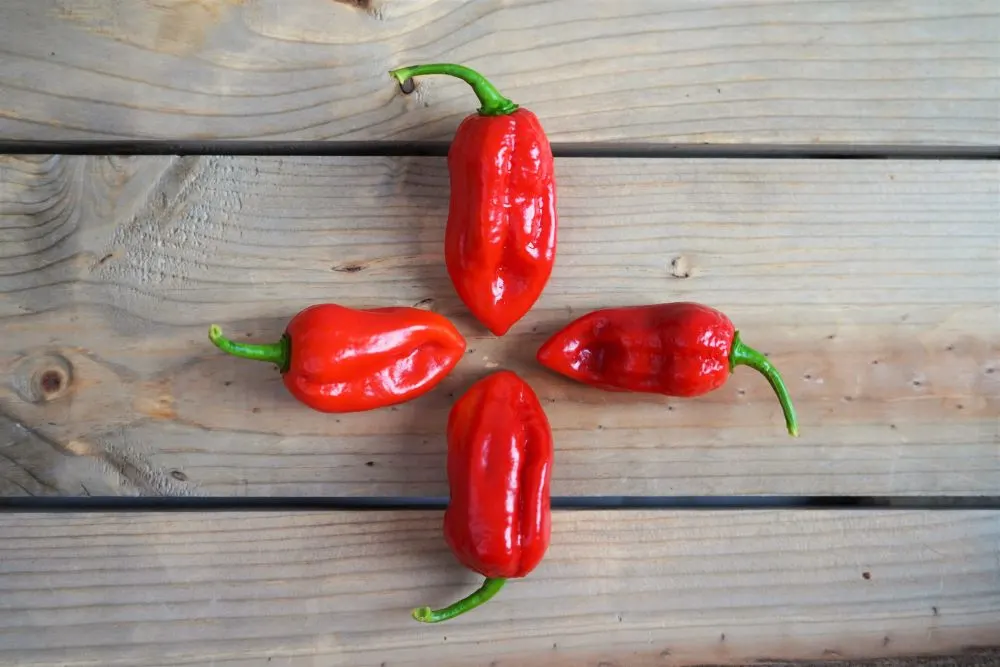
In India, the ghost pepper was cultivated by local hands and still grows naturally in Northeastern India. Though the exact origins are unknown, this is the most likely course of events for the ghost pepper.
Fun fact: Naga means ‘Serpent’ in Sanskrit. Many ghost pepper varieties are named after Nagaland, India, where the peppers grow naturally.
We are happy that the pepper was discovered and seeds are now widely available across the globe for home growers!
Ghost Pepper Plants
Like most pepper varieties, ghost pepper plants are fairly easy to grow and the pods are highly resistant to pests. We recommend buying seeds online and growing them yourself. However, there are ways to buy live plants as well.
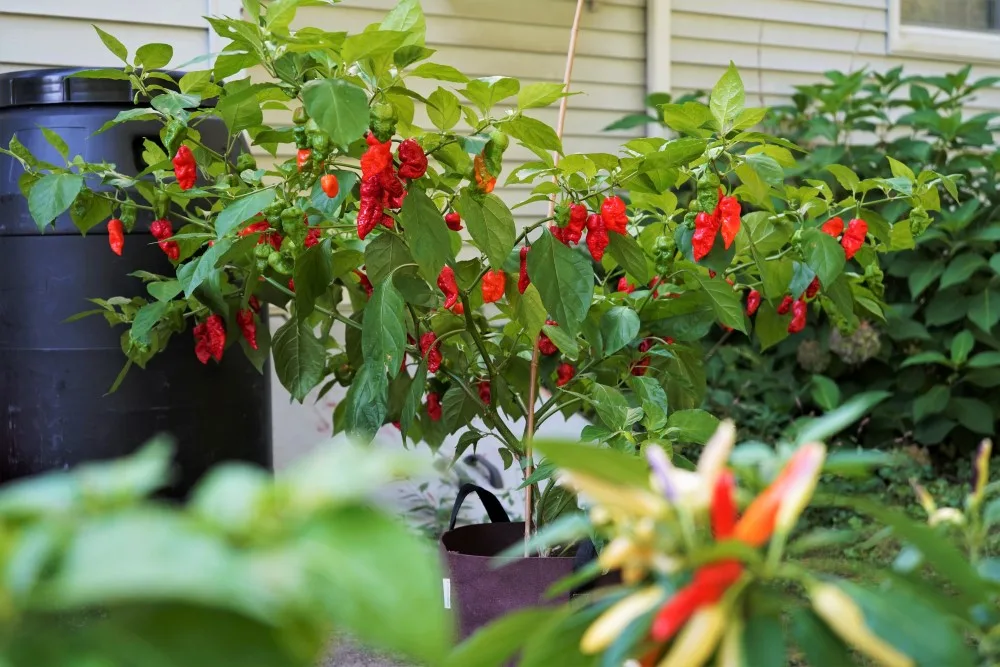
Ghost Pepper Plant Features
All ghost pepper plant varieties have large, broad leaves and a full canopy. Flowers are small to medium in size, and are usually white. Ghost pepper plants are also highly productive under ideal growing conditions.
Pruning is optional for ghost pepper plants, though we recommend at least bottom pruning to protect against soil borne pathogens. All ghost varieties are slow to mature, so we recommend starting seeds very early indoors.
Ghost pepper plants plants typically take 100+ days after transplanting to produce fully ripened pepper pods!
Given enough soil, light, and fertilizer, ghost peppers will grow to about 2-4 feet tall in a single season, but can often be very wide, around 5 feet or more. Certain ghost pepper varieties, such as the Dorset naga, can grow to be much taller and wider when given a long growing season and lots of soil.
Learn to grow ghost peppers from seed here.
Where To Buy Ghost Pepper Plants
If you want to grow ghost peppers at home, you can either start from seed, or you can simply buy live plants online. Ghost pepper plants are not a huge demand, so you likely won’t find them at Home Depot or Lowe’s.
Try calling your local nurseries to see if they sell ghost pepper plant starts. Many gardening centers cater to the local demand, so if you call asking, they might carry them next year!
Ghost Pepper Scoville Scale
A common question regarding the ghost pepper is how spicy it is. Where does the ghost pepper stack up on the Scoville Scale?
Put simply, the ghost pepper comes in at approximately 1,000,000 SHUs on the Scoville Scale. This was enough to hold the Guinness World Record for the world’s hottest chili pepper for about 4 years from 2007 to 2011.
When compared to a common hot pepper, say a jalapeño, it isn’t even close.
A single ghost pepper is about as spicy as 125 jalapeño peppers!
Since it has been dethroned, the ghost pepper seems tame compared to the new hottest peppers. However, don’t be fooled. The ghost pepper is still an extremely spicy pepper variety, and will give almost anyone a run for their money!
Different Ghost Pepper Colors
One of the great things about pepper crossbreeding is the amazing diversity that we now have. There are ghost peppers of all different colors and sizes. While the various types may look different, bhut jolokia peppers are always super spicy.
Jay’s Peach Ghost Pepper
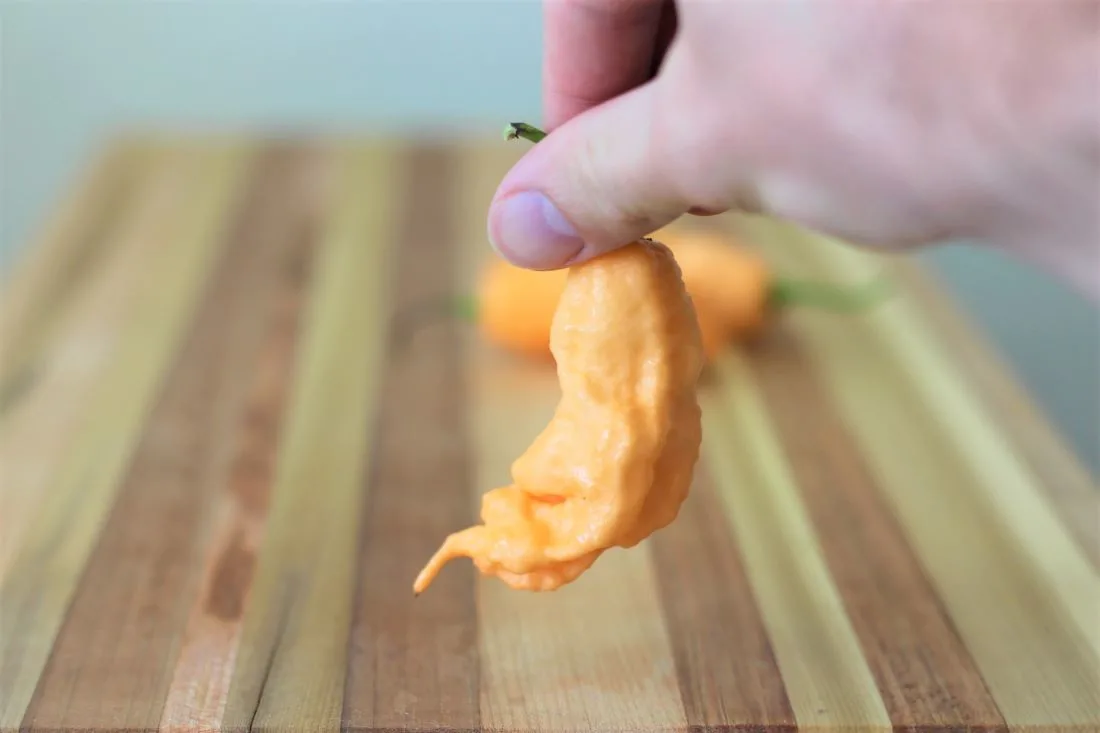
Behind the peachy exterior of this bhut jolokia variety is a serious punch. Similarly spicy to the original pepper, the Jay’s peach ghost pepper is no joke.
We love growing this variety, as the ripe pods add a beautiful color to the garden.
Yellow Naga Ghost Pepper
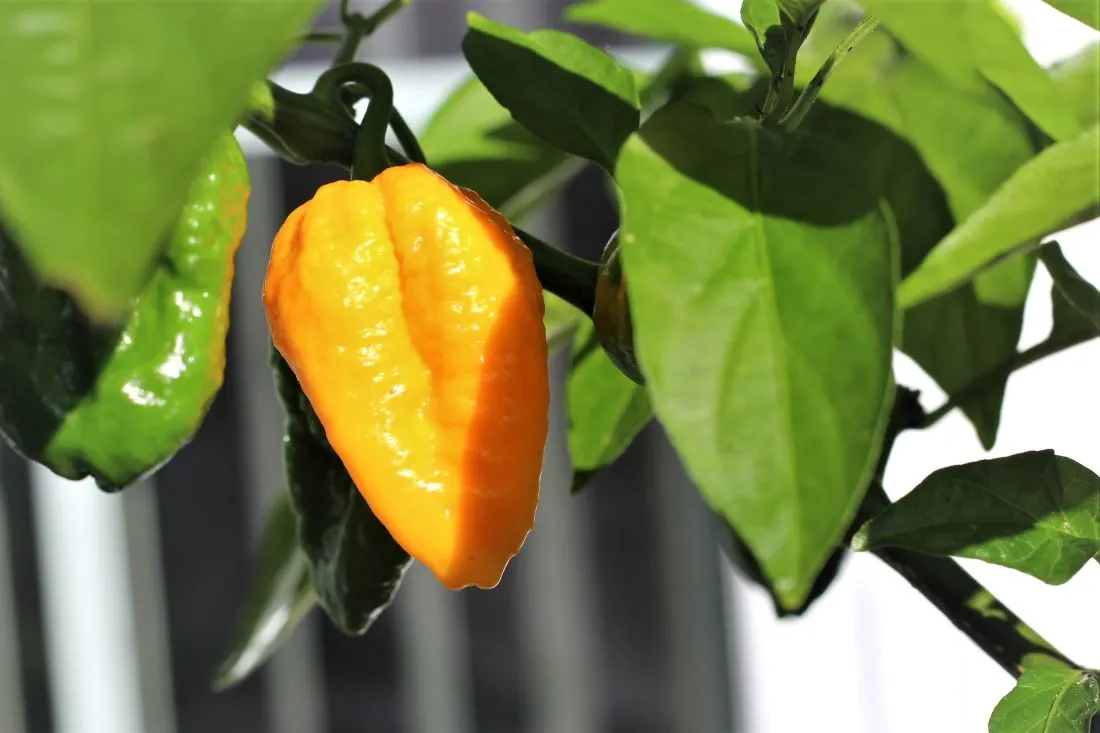
Another brightly colored ghost pepper variety, the yellow naga pepper is a beaut. We had great luck with these plants, with peppers ripening as early as mid-July (super early for ghost peppers)!
Add a splash of yellow to your garden with these ghost peppers. You’ll have no trouble knowing when to pick these.
Chocolate Ghost Pepper

This ghost pepper has a much more sinister look, and a truly scorching heat level. The chocolate, or brown bhut jolokia pepper, is a monster!
Note: This is the spiciest ghost pepper color variety we have tried to date!
Once again, we had relatively early ripening from these plants. A great, bizarre look in the garden, and perfect for making extra-spicy foods.
Growing Ghost Peppers
Growing ghost peppers is similar to growing other pepper varieties. Surprisingly, ghost peppers are one of the easiest hot peppers to grow, which makes them a bit dangerous to those who haven’t tasted their heat level.
Follow our detailed guide to growing ghost peppers here.
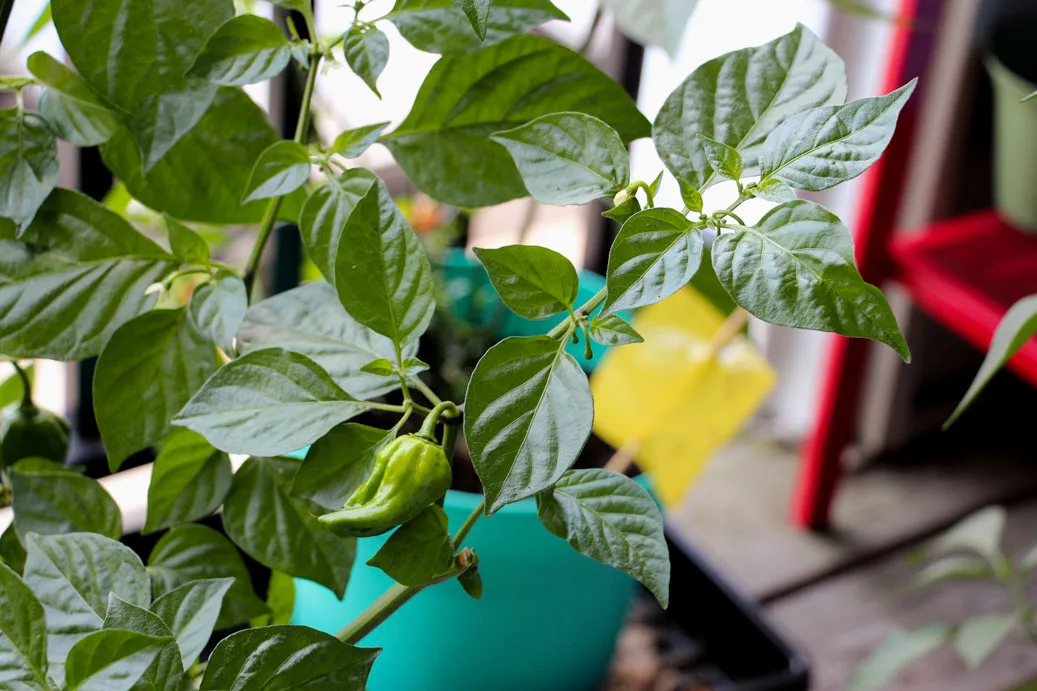
However, there are a few things to know specifically about growing ghost peppers.
Some things to keep in mind about ghost peppers:
- Seeds may take longer to germinate. Ghost pepper seeds (and other super hot varieties) are know for being very stubborn to sprout. They can take weeks, sometimes up to one month to germinate.
- We highly recommend bottom heating with a seed mat.
- Growing season is longer. Some early pepper varieties can take as little as 75 days to have mature pods. Ghost peppers will need at least 100 days from the day of transplanting to produce ripe peppers.
- Beware of handling the pods. While the outer skin of a ghost pepper does not contain capsaicin, a small crack can let out a ton of it. We recommend using latex gloves whenever you plan to handle the fresh peppers (especially when slicing them).
When To Pick Ghost Peppers
Knowing when to pick your ghost peppers is usually very easy. All peppers, including ghost peppers, will change color when fully ripened. Unlike jalapeños or banana peppers, ghost peppers are almost always picked when fully ripe.
In short, pick ghost peppers when they change in color from green to bright red (or whatever color variety you are growing). The change in color is obvious and will usually take just a few days once the peppers begin to turn.
Signs of ripe ghost peppers:
- Change in color
- Mature size
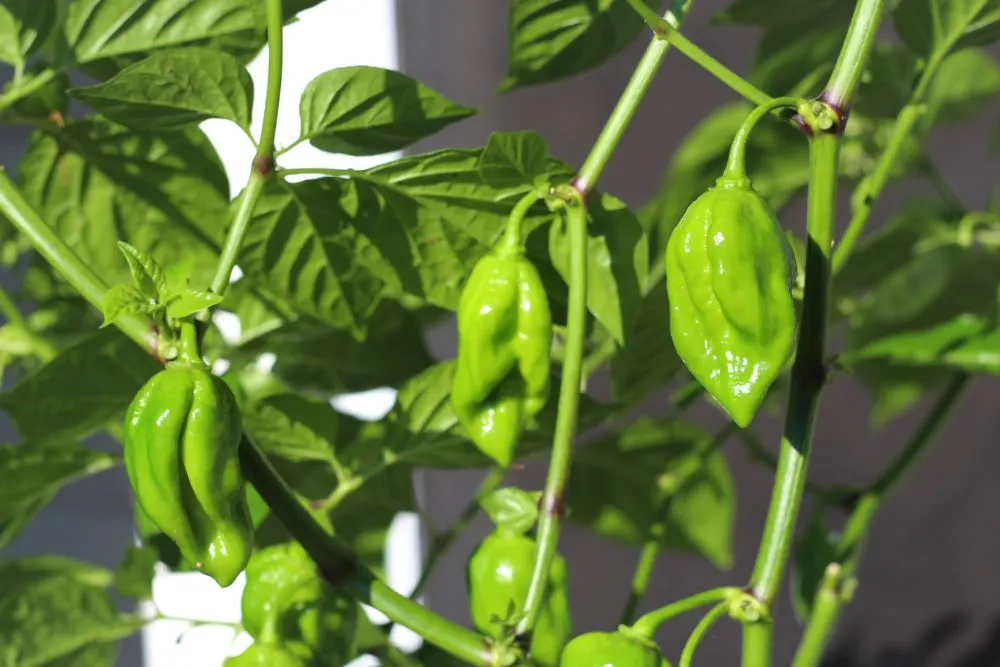
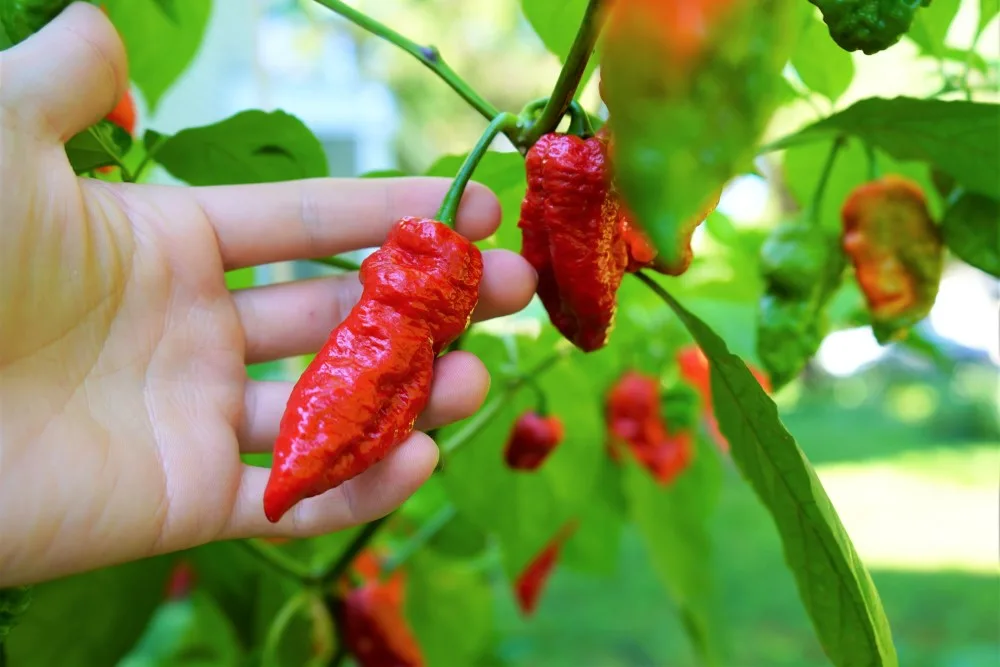
How to pick ghost peppers
Our method for harvesting ghost peppers is simple: Remove the peppers with your hands, careful not to damage the plant. We find that an upwards motion works well to get a clean ‘pop’ as the pepper is removed.
Another option for harvesting ghost peppers is to use sharp scissors or pruning shears. Simply cut the pepper’s stem about halfway up, being careful not to nick the plant’s branches or leaves.
Where To Buy Ghost Peppers
Not looking to grow ghost peppers yourself, but still want some fresh peppers? You’ve still got options. Here are some places where you can buy ghost peppers (both online and in person).
Thanks to the huge boom in popularity of spicy food, the ghost pepper is famous. That means you may start seeing fresh bhut jolokia peppers for sale in specialty grocery stores.
We have personally seen them for sale (during the summer months) at Whole Foods Market. You can also buy fresh ghost peppers online from individual growers.
Ghost Pepper Uses
Ready to start using some ghost peppers from the garden? These versatile spicy peppers can be used in a number of ways. You can preserve them for later use, use them fresh, dehydrate them for spicy pepper powder, and even save the seeds to grow again next year.
Warning: Always take precautions when slicing or cooking with ghost peppers. Wear gloves, eye protection, and respiratory protection. You’ll thank us later!
Ferment Them
Ghost peppers make a delicious fermented pepper mash. This natural and ancient process preserves your fresh produce, while also developing a rich and complex flavor.
After your fermented mash is finished, you can store it in the refrigerator for many months, or use it to make an easy hot sauce. Try fermenting your ghost peppers with other produce such as onions, carrots, tomatoes, fruits, and other peppers!
Make a Ghost Pepper Hot Sauce
We sure do love making homemade hot sauce. You get a ton of sauce for your hard work, and it is a wonderful preservation method.

Using a simple preparation of peppers, vinegar, salt and any other fruits and spices, you can blend up your very own sauce. However, go easy on the ghost peppers (try using some jalapeños to decrease the heat level). A single ghost pepper is plenty hot to spice up a whole bottle of hot sauce!
Tip: We love using fresh fruits, especially pineapple or blueberries, in our sauces. Get creative!
Make Ghost Pepper Salsa
Making a super-spicy ghost pepper salsa is a great way to use a few ghost peppers. Similar to hot sauce, this vinegar, tomato and onion based dip is a classic. Usually made with jalapeños, salsa is begging to be made spicier.
Put Them In Some Chili
You’ll want to be careful not to overdo this, but you can try making some ghost pepper chili. Throw a half of a pepper, finely chopped, into your next batch of chili to kick things up.
Dehydrate
We love dehydrating foods, especially peppers. This is a great option if you want to save your peppers for later, or create a spicy pepper powder.
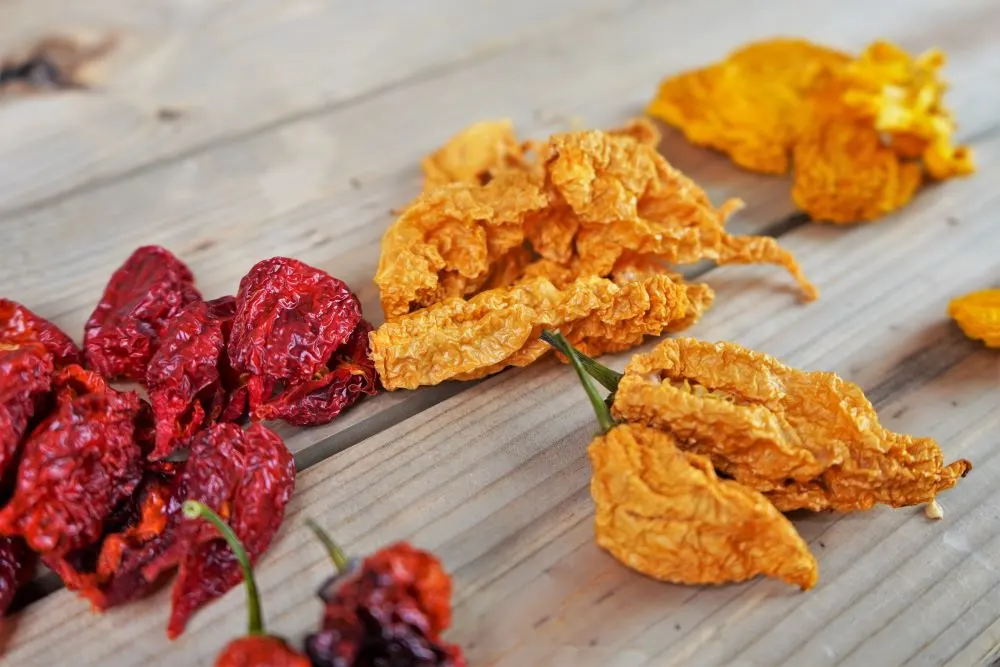
Slice your bhut jolokia peppers in half lengthwise before dehydrating. These peppers are thin, so they should dehydrate in around 8-10 hours at 125°F (in a proper food dehydrator).
Saving Ghost Pepper Seeds
Saving pepper seeds can be worth the extra effort. Seeds will stay viable for years if stored properly, meaning you can re-grow your favorites in the future.
We wrote a detailed guide on saving pepper seeds here.
How to save ghost pepper seeds:
- Wear nitrile gloves (important!)
- Choose fully ripe ghost peppers
- Slice the peppers lengthwise
- Use a spoon to remove the seeds from each half
- Dry seeds on a paper plate for several days (using a fan can speed up the process)
- Store in an airtight container in a cool, dark location
Ghost Pepper Relief and Cure
If you are new to spicy food, and happen to try a ghost pepper, you’ll likely need some relief from the pain. The quickest relief is cold milk.
If you have any dairy milk in the fridge, go for that first. It offers the quickest and best relief from any type of chili pepper burn.
If you got some of the ghost pepper oils on your hands, milk is still the best help. However, we also recommend scrubbing your hands thoroughly (even under the nails) with dish soap. The detergent in the soap helps emulsify and remove the pepper juices.
Can A Ghost Pepper Kill You?
While eating capsaicin (the chemical compound responsible for the “burn”) is not toxic, it can cause rare adverse reactions in some people.
There have been cases of people vomiting aggressively after eating ghost peppers, leading to potential esophageal rupture. Though the pepper itself is not fatal when eaten, the reaction in some people may be.
Know what you are eating, first!
If you have never tried a highly spicy pepper, we don’t recommend eating ghost peppers. Work your way up from less spicy varieties like jalapeños and serranos.
I hope this article helped you learn a few new things about ghost peppers. They are amazing peppers to respect and enjoy in moderation.


W Edmund Chambers II
Tuesday 17th of October 2023
The capsaicin in a ghost pepper is not water soluble, it is alcohol soluble which means waking your hands with soap and water usually does not work well. Using alcohol is best at removing the burn. Grain alcohol or vodka work very well. Do not ingest alcohol to tame the burn as when you swallow, you may pull the capsaicin further down your throat causing more pain.
Kay
Sunday 26th of February 2023
The bhut jolokia sound wildly hot. Would like to try it plus the different colors and otherbextra hot peppers. Am not up-to-date on using my tablet to order anything and was wondering if you could supply a company with phone no. address, I would aporeciate it. Thanks.
Vivian
Thursday 28th of July 2022
Hey Calvin! Thanks for all your pepper wisdoms! I'm a fan! This is my first year growing super-hot peppers, and I'm learning so much from you! I'm growing Carolina Reaper, Ghost, Trinidad Scorpion, Scotch Bonnet, and Habanero. I finally have some Scotch Bonnets and a Ghost pepper ripen. It's very exciting, but I'm holding back on picking them, wondering if it'll get hotter the longer I leave it on the plant to ripen further. Does the SHU increase with number of days the ripe pepper stays on the plant before harvesting?
peppergeek
Tuesday 2nd of August 2022
Hey there, thank you! Glad you enjoy our content here :). Sounds like you like it super spicy! Most of those types should stay pretty crisp on the plant without drying out, so that is a plus. However, they should hit peak-heat level right around the time they finish ripening up. Don't worry though, they'll still be plenty hot if you let them sit for a few weeks. Cheers!
Tom
Monday 2nd of May 2022
Hey guys, love your work, I have consulted you often while putting my new sauce company together. My first small batch is being made on Wednesday. Where can I find ghost, scorpion or 7 pots in the North Ga area? Are they even available to buy on line? I'm looking for peppers, not seeds or plants, I have found them all over.
I have created a fantastic Caribbean style sauce using Habaneros but would like to use a more "Caribbean" pepper.
peppergeek
Monday 2nd of May 2022
I would reach out to other sauce companies that use those ingredients. We've talked with the good people at Karma Sauce co and they definitely source scorpions/other superhots, just not sure exactly where. Best of luck and would love to try your sauce once it is for sale!